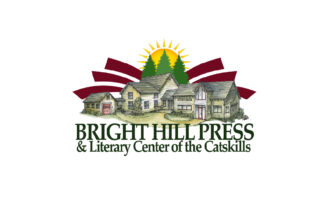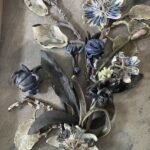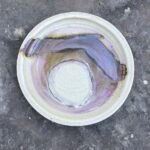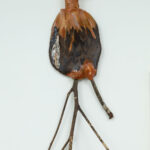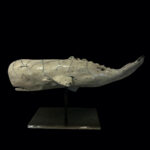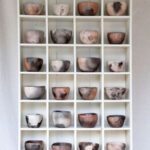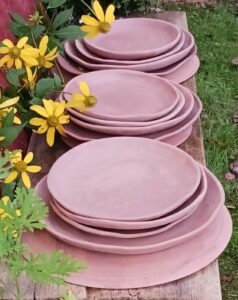
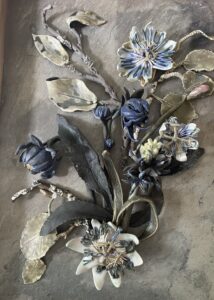
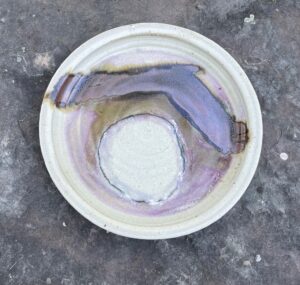
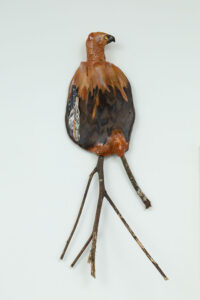

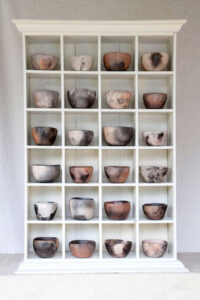
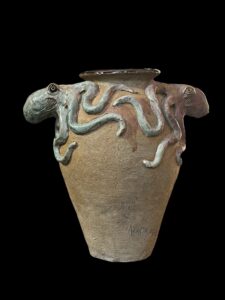
Artist Discussion: from function to fantasy
Moderated by Mary Carlson
Bright Hill Press presented plate platter plant place prey, an exhibition curated by artist Jody Isaacson, honoring her upstate New York ceramic mentors working in a range of ceramic materials and firing practices. Isaacson selected each artist to produce work that falls into a category they currently explore in their practice. Although her work does not mirror any of the selected artists, they lit a fire in Isaacson to engage with clay, a material whose memory to touch complemented her woodblock printing. Plant (Diana Hall), Plate (Carlyle Bradford), Platter (Elizabeth Nields), Place (Steve Clorfeine, Joe Kurhajec and Matthew Smith), and Prey (Jody Isaacson).
A moderated discussion with Mary Carlson took place On October 12, 2024.
The Artists
Carl Bradford
The Plate
Plates are like flying saucers! Not unlike children playing musical chairs. Not knowing where they will land, or for how long. Ready for flight. They take up residence on tables, in sinks, on counter tops, where you least expect them, or quietly resting in cupboards where they are visually engaging.
They provide other activities, presenting food from the garden, conversation, and willing to hold almost anything. Engaging themselves in our daily relationships.
The plate from its humble beginnings offers the shared experience of the kindness of giving and the thankfulness of receiving.
Clay is always inspiring. It will always be a challenge.
A way of life and a very humbling experience
Carlyle Bradford comes from an extended family of clay artists and potters. She apprenticed in a production studio for four years, from mud pits to refining a functional and beautiful pot. She and her husband opened a pottery shop in Delaware County in 1984. She exhibits in shows across the Northeast. She belongs to the Catskill Mountain Artisans Guild and has also taught many workshops for children and adults, including Head Start Programs and Children’s Sunday School programs.
Steve Clorfeine
24 Bowls
Fired in a galvanized barrel with organic materials: sawdust, grass clippings, scrap wood, banana peels, corn husks, tea leaves, coffee grounds, kosher salt, copper carbonate, red iron oxide (2020-’21)
Over the past two years, making these bowls has been a passion, when for the first time, I could fire them with local materials on my own land. It’s a process that relies on many elements: wind, smoke, the right wood and sawdust, placement of the bowls in the kiln (galvanized barrel), the heat of the fire, and ultimately serendipity. The bowls are given over to the fire (Agni, the fire god) and the following morning they are delivered sunk in ash and warm embers.
Steve Clorfeine started making pots in 1970 and began again in 2003. Since childhood, he has been attracted to the artifacts of potters from ancient civilizations. As a performer, teacher, and persistent traveler, he has looked at and bought ceramics, from East Indian and Mexican tiles to Swiss and German mid-century pottery to classic Native American bowls. He is particularly interested in Acoma Pueblo (New Mexico) “pinch pots.”
Diana Hall
Still Life with Flowers
I grew up with my friends in the woods, meadows, and the swamps. Clay is my passport that brings me back to my friends. Plants are my life’s breath. Food, clothing, and shelter from all of life’s hard edges.
Diana Hall has been working in clay since childhood. She minored in ceramics at SUNY New Paltz. At 57, she fell back in love with clay and began working on the wheel after joining the collective Smithy Clay Studio in Cooperstown. She became completely absorbed in the natural world, sculpting flowers, and making sculptures with a floral component. She lives in Franklin, NY.
Jody Isaacson
Watcher
For the past 40 years, I have worked with the passage of time, movement, making, memory, and loss.
I sketch, scavenge, saw, scratch, scrape, sew, stitch, sand, capture, cut, carve, cast, collage, brayer, paint, print, dip, dye, grommet, weave, glue, rub, reduce, tape, transfer, trim, pour, pound, roll, press, glaze, fire, and burn. I do these things over and over til they come out “right.” I’m also interested in the way a ‘wrongness’ or a ‘differentness’ can also be asserted as a new kind of rightness.
Jody Isaacson earned her BFA from the University of Wisconsin and her MFA from the California College of the Arts. She has shown locally and all over the country, including the Arts Club in Washington DC, the Albuquerque Museum, and the Museum of Fine Arts in Santa Fe, with KIPNZ in Walton, NY; Greg Kucera Gallery in Seattle, WA; St. Catherine University in St. Paul, MN; The Print Club in Philadelphia, PA; The Santa Fe Art Museum and Nevada Art Museum in Reno, NV. She lives in Sidney Center, NY.
Joe Kurhajec
Vessel 1
“I believe we learn to make sculpture by making sculpture. Every sculpture is the creation of a dedicated, precise set of acts, physical or intellectual, from which comes the form of achievement, a satisfaction of the spirit. One becomes in some way a tool in the hand of God. I continue to search in every sculpture for some act of vision, of faith, of desires.”
Art is eternal: for it reveals the inner landscape which is the soul of the man. Let the works speak for themselves.”
What is art to you?
“
My reason for being.”
Joe Kurhajec is a sculptor, painter, and printmaker. Mayan art and culture are a continual source of inspiration. Kurhajec has explored the dimensional possibilities in printmaking; his prints take on textured surfaces borrowed from nature with calligraphic techniques, using animal furs and hair, scales, and other organic materials. He has exhibited his work throughout the U.S. and abroad. He divides his time between Treadwell, the Yucatan, and Paris.
Elizabeth Nields
Platter with Markings and Oxblood Glaze
Plates are both useful to hold food and to present food. Platters and plates also can be an opportunity for showing off food, a backdrop for an artistic arrangement of foods… a charcuterie board is an example of that. Some use a quiet background; others even use a textured surface to hide gourmet treats in a landscape of the surface of the clay. I love making paintings in clay or on clay. Again, there is a conversation between the clay itself and the artist. These pieces, paintings on clay, have nothing to do with food at all.
Elizabeth Nields has always loved to paint and make things from clay. She apprenticed with potter Judy Baldwin and taught at Adelphi University and Hofstra. She creates sculptures with clay, sometimes large vessels with figures and animals that might have come from an ancient religion. She and painter Roy Colonna moved to Upstate New York and created studio space. Nields has led workshops and has also taught at Hartwick and SUCO. She particularly enjoys making large sculptures. She lives in Otego, NY.
Matthew Smith
Moby V111
I make sculptures of living beings. I Raku those sculptures as a means of conveying the unique response that beings have to the stressors the world imposes. The essence of Raku lies in its unpredictability and the acceptance of imperfection. Each piece embodies the philosophy of ‘happiness in the accident,’ where the final outcome is left to chance and the unique conditions of each firing. The adaptations, replete with flaws and idiosyncrasies represent the beauty of life’s response to living.
Matthew Linton Smith grew up in Arkansas and attended Rhodes College in Memphis, Tennessee, where he studied under Lawrence (Lon) Anthony. Later, after moving to Santa Fe, he studied Raku under Kellogg Johnson. He shows his Raku Sperm Whales at the North Water Gallery in Edgartown, Martha’s Vineyard, MA. Matthew lives in Santa Fe, NM.
Mary Carlson – Moderator
Mary Carlson is an artist who lives in Brooklyn and Walton. She shows her work at Kerry Schuss Gallery, NYC.
